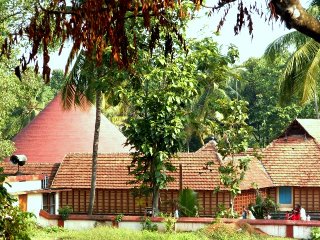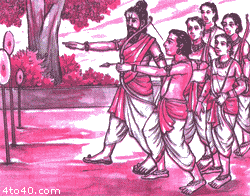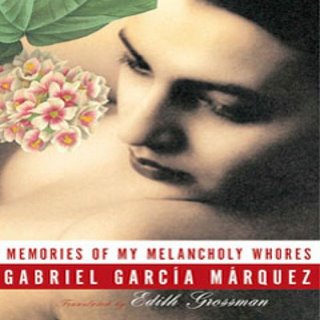1. Edapally Ganapathy Temple
2. Uragathu Amman aka Amman Thiruvadi
3. Vaikom Mahadeva Temple
4. Chottanikara Bagavathy Temple
5. Thirupunithura Temple
6. Ernakulathappan Temple
7. Thiruvanjikulam Temple
8. Alathiyur Hanuman Temple – Hanuman Kavu
9. Kodungallur
10. Thiruparayar Ramar Temple
11. Aarattupuzha Ayyappan
13. Thiruparangoad Shiva Temple
14. Chamaravattathu Ayyappan Temple
Temples in Kerala are referred to as Kshetram or Ambalam. Temples open in the wee hours and close an hour before noon and reopen by 4pm and finally close by 8pm. Strict dress codes are followed in temples here. Men enter the temples in dhoties and bare chest and women in traditional mundus or saris. Their costumes, oiled and plaited hair, sandal paste smeared on their forehead adds more beauty to their faces and makes every stranger gawk at everyone. Any day this is much better than watching celebrities walk on the red carpet and ramps.
Edapally Ganapathy Temple:We started the day by visiting the Ganapathy temple at Edapally Palace. The temple enshrined only Ganesha and he was all decked up with jewels and a garland made of grass (dhoorva). Praying for a good beginning we proceeded to Mahadeva temple at Vaikom.
Mahadeva Temple:Shiva - Vaikom Mahadevar manifests himself as Dakshinamurthy in the panthirathi pooja in the morning. He is worshipped as Kiraata Murthy during the Uchcha pooja at noon and as Satchitananda in the evening. Vaikom Mahadeva is also referred to as Annadaana Prabhu. Shiva is not in a Aavudayar or Linga form here, he has got a human form in this temple. Parvathi is worshipped as the vama bagham of Shiva.
After visiting the Son and the Father we proceeded towards Chottanikara to visit the mother, enshrined there as Bagawathi. It was 7:30 am in the morning there the queue was already half km long. No one good thing in Kerala is that we don’t have special darshan tickets where we can flaunt out wealth and get quick darshan. No disparities, all are treated equal in the kingdom of God.
Chottanikara:
Rajarajeswari is the presiding deity here. The image of Bhagawati (Rajarajeswari) is of laterite; untouched by the human sculptor, this image is of irregular shape and is covered with a golden kavacham. This deity is worshipped in three different forms - as Saraswati in the morning - draped in white, as Bhadrakali at noon draped in crimson, and as Durga in the evening decked in blue. Morning ablutions were happening as we entered the temple and we were able see her without the golden kavacham.

To the north east there is a flight of steps leading to the Keezhkaavu, a shrine to Bhadrakali. In the keezhkaavu shrine is a paala tree with hundreds of nails driven into its trunk, as a mark of devotees having been exorcised here. Worship here is believed to rid devotees of evil influences, psychological ailments, evil spirits etc. It was getting close to Rahukalam as we left the temple and women were dancing and loudly complaining their stories to the mother goddess. At times it was sad to hear their story, but this seems to be therapeutic for folks who suffer from psychological illness.
There was a long line by the time we reached this temple and it was half past 9.00 in the morning. We decided to wait in the line to visit this magnificent temple built by Arjuna.
Thirupunithura:
Vishnu here is worshipped here as Santhana Gopalan and it is believed that he offers children to the childless couples upon prayer. This deity is Kula Daivam of Cochin Royal family.
Thirukatkara:
The Vamanamurthy Temple at Trikakkara is an ancient one. Onam is the most important festival celebrated in Kerala.This temple is associated with the Onam festival and the last day Onam marking the avataram of Vamana and the banishment of Mahabali Chakravarti to the netherworld.

We offered a long Lotus garland to the deity at the temple and prayed for world peace and prosperity. Temples in Kerala use Sandal paste very creatively. They had used kalabam (Sandal paste) to bring out the emotions of the deity. Vamana was profusely happy and was captivating smile on his face was radiating energy. Right besides the Vamam temple there is a Shiva shrine and it is believed that the shrine was built by Kind Mahabali.
The temple architecture is an amalgam of stonework, wood work, stucco work and painting - harmoniously blended into a structure vibrant with traditions of the region. The shape of the roof is in accordance with the plan of the sanctum below. With a circular plan, one sees a conical roof, while with a square plan the roof is pyramidal. The roof is constructed with wood and is covered with copper plates. The roof projects out at several levels, in order to protect the inner skeletal framework from the vigorous monsoons that inundate the region. The temple walls are of coursed laterite stone masonry plastered in mud and lime. Murals are seen on several of these temple walls. Mammiyoor style of painting is usually found on the exterior walls of the garbhagraham depicting scenes from Mahabaratha and Ramayana and other epics. Some of the paintings transgress into Khujraho themes showing the union of the male and female goddess.
Ernakulathappan:
We took advantage of Vishu and temple timings that day. We went back to Ernakulam and got a darshan at the Shiva temple there. The temple faces Cochin harbour and we could see ships moving into the harbor right from the temple entrance. A legend associated with this temple is believed to be related to the name of the city itself. Arjuna is believed to have worshipped Shiva in this temple.
Another important seva that we can offer at the temples in Kerala is the firework seva aka vedi Vazhipadu. We pay the temple to burst fireworks during the pooja and this is believed to ward off evil spirits and negative vibrations.
We were able to spot a vegetarian restaurant, Hotel Udipi and we had our brunch before we retired for the morning. The rain that came down hard the previous evening doesn’t seem to do much good. The sun was busy evaporating the rain water and it felt like a steam room outside.
Keralites consider visiting all three Shiva temples at Vaikom, Etumanoor, Kaduthuruthi on the same day to be very auspicious. I hinted Vinod that we would like to visit the all three temples on the same day and with much delight he got enthusiastic to drive us around. We left the room at around 3.00 pm and headed north towards other temples.
Thiruvanjikulam:
Tiru Anjaikkalam is the only Shivastalam in Kerala and in Chera Naadu which has been sung by the Nayanmars. Dakshinamurthy, contrary to the name faces the East here. The sanctum is in the form of a chariot and there is no separate shrine for Ambal. Unlike most other Shiva temples in Kerala, there is an image of Nataraja here.

Three Devi shrines in Kerala are very popular, Chottanikara, Kodungallur, Paramekkavu. Kodungallur was just 8 kms away from the Thiruvanjikulam and we decided to head there for the Sayaraksha.
Kodungallur:
Bagawathi here is considered a manifestation of Kali in the form of Kannagi. The image of Kali faces east. The image of Bhagawati is believed to have been carved out of a jack fruit three. The face of the image is covered with a mask, and the image is decorated with several pieces of jeweelry. She holds 8 different kinds of weapons in her hands and one can see only love in her eyes and no sense of fear. There is a crimson cloth hung on the western wall of the sanctum and worship is offered here. There is also a secret chamber east of the Kali image, with an underground passage. Also is a shrine to Kshetrapala, the guardian deity and Vasurimala associated with small pox. It was nice to be there at Sayaraksha and absorb the powerful vibrations of Chenda and recitation of Durga Sooktham. Lamps were lit in the outer maadam and the entire temple town was glowing. This image is believed to be a personification of Kali, who had killed the demon Daaruka. Daaruka is said to have worshipped Bhrama, and harassed the devas. The goddesses created Bhramani, Vaishnavi, Maheswari, Kaumari, Varahi and Indrani from Bhrama, vishnu, Mahadeva, Kumara, Yama and Indra, and they were defeated by Daaruka, however Shiva created Kaali and she killed Daaruka.
The temple has an unusual system during its festival. During the seven-day long festivals obscenic songs are sung by the devotees to appease the deity. The intensity of the songs has come down considerably following vehement protests from various learned sections. The government is afraid of banning it, fearing backlash from some sections. Yet another unusual ritualistic custom also prevails here – butchering of chicken during the festival. There is a marked venue and Kozhikallue (chicken-stone) for this purpose.
Believe it or not, thousands of pilgrims, mostly from Kasargode and Kannur districts (north end of Kerala – Thrissur is in the middle of Kerala) with swords in hands come during the festival. With swords in hand they agitatingly dance before the temple to appease the goddess and earn her blessings for well-being.
Thiruparayar Ramar Temple:
We left after Kodungallur after the arthi to the Ramar temple at Thiruparayar. The temple is situated at an enchanting spot on the west bank of the Thriprayar river. Gradeur of the structure, the style, strictly conforms to the principles of Vaasthu Shastra. The river, swaying trees - no only are they beautiful, they seem to echoing the Rama Nama in their every movement. The beautiful anitque idol of Rama is sculpted from a rare stone and according to mythology, the idol changed hands from Vishnu, Brahma, Dasaratha, King of Ayodhya, and Vasudeva o f Mathurabefore finally reaching Thriprayar. The bewitching beauty and serenity in the idol's face is symbolic of Lord's mission to propogate dharma, after vanquishing Ravana, who was adharma incarnate. Idols of mother earth, Dakshinamurthy and Ganesh are also installed in the temple.
It was close to 8.00 pm when we reached the temple and the priests were preparing the lord the last kala pooja for the day. We took a pradhakshinam on the outer prakaram and we found couple of interesting customs.The temple's customs have two unusual features: One is the firing of country rockets. facilities for which are provided at the southern corner of the temple.
The explosion symnbolise Hanuman's welcoming words of Cheer to Sri Rama- Drishtaa Sita has been seen after returning from his Lank search mission. This he did to assure a worried Rama that Sita was alive and well. We paid for the serivce to fire rockets. Another unusual offering made by devotees visting Thriprayar in the river, recalling the Matysavathar of Vishnu is the feeding of grains to the scoal of fish in the river. The splashing of water by the fish is considered to be a blessing by the Lord. Every god in the hindu mythology has an animal that he/she uses as a vehicle and it is considered to be sacred and every temple adopts a tree "Sthala Vruksham". It is interesting to note that how religions take care of animals and ecosystem.
In the meantime it started to get dark and windy and black clouds engulfed the clear sky in minutes. We had a darshan of the Rama with very less clothes and jewels and enjoyed his nija roopa from head to toe. In the meantime the priests were ready to carry out the utsava moorthy on top of the elephant for a procession around the temple. The wind started to pick up and moisture laden clouds start to sprinkle water everywhere. Instruments playing and people chanting hymns followed the Perumal on elephant. At the right time the electricity also went off the fire torch provided the right ambience to enjoy the almighty in a natural setting. As we exited the temple the summer rains came really hard.
We waited 30 mins in the car park for the rain to subside and then drove towards Trichur. It was already 30 minutes past 8 and had been looking around for a vegetarian restaurant and by the time we reached Trichur they were all closed. We chugged down a few oranges and a bottle of water and rested that night at Trichur.


















 Sri Vilwadri Mahatmya, a Sanskrit text with 18 chapters, describes the origin of this ancient temple. It is in the form of a conversation between Uma (Parvati) and Maheswara (Siva). According to this, Bhargava Rama, as Parasurama is called, prayed to Siva for the liberation of his pitrus. Pleased with the prayers of Parasurama, Parameswara granted him the image of Vishnu which He Himself was worshipping. Parasurama, in his search for a suitable place for the installation of the deity, came across the beautiful Vilwadri, full of Amala trees. He constructed a temple here, consecrated the deity and laid down the pooja routine. He brought the pirtus and got them liberated as a result of the darshan of the divine deity. The place he settled down finally is still known as Bhutan mala.
Sri Vilwadri Mahatmya, a Sanskrit text with 18 chapters, describes the origin of this ancient temple. It is in the form of a conversation between Uma (Parvati) and Maheswara (Siva). According to this, Bhargava Rama, as Parasurama is called, prayed to Siva for the liberation of his pitrus. Pleased with the prayers of Parasurama, Parameswara granted him the image of Vishnu which He Himself was worshipping. Parasurama, in his search for a suitable place for the installation of the deity, came across the beautiful Vilwadri, full of Amala trees. He constructed a temple here, consecrated the deity and laid down the pooja routine. He brought the pirtus and got them liberated as a result of the darshan of the divine deity. The place he settled down finally is still known as Bhutan mala.
